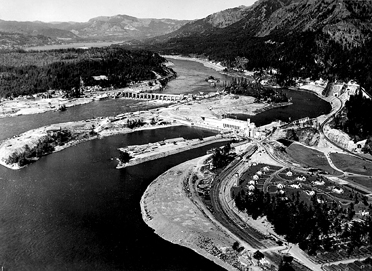In 1980, after four years of deliberation and several attempts, Congress passed a law intended to ensure low-cost electricity to Northwest ratepayers from federal dams in the Columbia River Basin and money from those same ratepayers to mitigate the impacts of the dams on fish and wildlife.
The Northwest Power Act (Public Law 96-501), signed by President Jimmy Carter in December 1980 shortly before he left office, authorized Idaho, Montana, Oregon, and Washington to form an interstate compact to accomplish three things: (1) prepare a plan to assure the Northwest of an adequate, efficient, economical, and reliable power supply; (2) prepare as part of the power plan a program to protect, mitigate, and enhance fish and wildlife that have been affected by hydropower dams in the Columbia River Basin; and (3) inform and involve the public about regional energy issues.
The Northwest Power and Conservation Council (called the Northwest Power Planning Council until 2003) has eight members, two from each state appointed by the governors to three-year terms. Headquarters, with sixty-five fulltime staff, are in Portland.
Consistent with the Power Act, the Council’s power plan and fish and wildlife program are implemented by the Bonneville Power Administration, a division of the U.S. Department of Energy. Bonneville sells the output of thirty-one federal dams and one nonfederal nuclear plant in the Northwest; it is the biggest supplier of electricity in the region. Bonneville sells its power at the cost of its generation, which makes it low-cost compared to power from most other suppliers.
The key resource to meet future demand for electricity in the Power Act is energy efficiency (conservation). Since 1980, the cost of efficiency improvements has been at least two-thirds the cost of any type of generating plant. By acquiring energy efficiency, fewer thermal power plants had to be built to meet increasing demand for power—something the region tried in the decade prior to the Power Act, with disastrous economic effects regarding nuclear plants. Primarily because of the Power Act, electricity-use efficiency has been improved in the Northwest since 1980 by an amount equal to the power use of more than four cities the size of Portland (in 2010). At the same time, Bonneville has directed a portion of its power-sales revenue to on-the-ground projects that address the effects of hydropower on fish and wildlife.
Access to Bonneville’s vast supply of inexpensive electricity was the central issue at the heart of the Power Act. By law, public utilities in the Northwest have preference to Bonneville’s power. Investor-owned utilities, however, served a large segment of the population, particularly in Oregon, with higher-cost electricity; they feared their access would diminish as demand grew. The Power Act leveled the cost of power for residential and small-farm ratepayers of public and private utilities. This was a dealmaker for Oregon’s members of Congress, most of whom supported the Power Act.
At the time, Senator Mark O. Hatfield commented: “Without any doubt, I predict it [the Northwest Power Act] will be viewed in the future as the most important bill ever to have affected the Pacific Northwest.” Senator Robert Packwood noted that customers of investor-owned utilities “will not be required to pay twice or three times the rate of those served by public utilities.” Packwood also praised the fish and wildlife planning in the Power Act, which he said “addresses the urgent need to improve the viability of salmon, which must pass by the hydroelectric facilities on our region’s rivers.”
Not everyone was pleased with the act. In the U.S. House, Oregon representatives Jim Weaver and Les AuCoin worried that the law would encourage construction of more nuclear plants and give “carte blanche to cost overruns.” Nevertheless, there was consensus, if not unanimity, among the Northwest congressional delegation, and the bill passed.
-
![]()
bonneville 2.
-
![Bonneville Dam]()
Bonneville Dam.
Bonneville Dam Courtesy Oreg. Hist. Soc. Research Lib., OrHi4295
-
![Bonneville Dam fish ladder]()
Bonneville Dam fish ladder.
Bonneville Dam fish ladder Courtesy Oreg. Hist. Soc. Research Lib., cn010651
-
![Fish ladder at Bonneville Dam, April 29, 1938.]()
Bonneville Dam, Apr 1938.
Fish ladder at Bonneville Dam, April 29, 1938. Oreg. State Univ. Archives, Wasco County Pioneer Assoc., WCPA 186B-1
Related Entries
-
![Bonneville Dam]()
Bonneville Dam
The U.S. Army Corps of Engineers built and operated Bonneville Lock and…
-
![Bonneville Power Administration]()
Bonneville Power Administration
In 1937, the impending completion of Bonneville Dam (1938) and progress…
-
![Columbia River Inter-Tribal Fish Commission]()
Columbia River Inter-Tribal Fish Commission
The Columbia River Inter-Tribal Fish Commission (CRITFC) is the fishery…
-
![The Dalles Dam]()
The Dalles Dam
The United States Army Corps of Engineers constructed The Dalles Dam be…
Map This on the Oregon History WayFinder
The Oregon History Wayfinder is an interactive map that identifies significant places, people, and events in Oregon history.
Further Reading
Bodi, Lorraine, "The history and legislative background of the Northwest Power Act." Environmental Law 25 (Spring 1995).
Northwest Power and Conservation Council. "Text of the Northwest Power Act." www.nwcouncil.org/library/poweract/default.htm.








